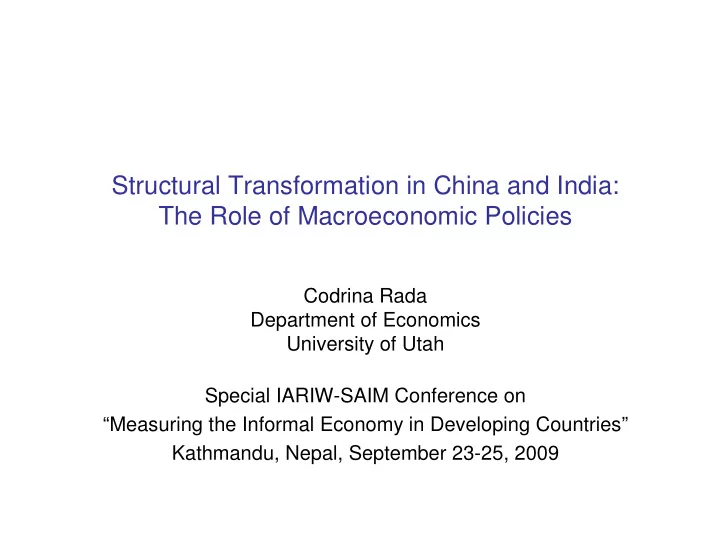

Structural Transformation in China and India: The Role of Macroeconomic Policies Codrina Rada Department of Economics University of Utah Special IARIW-SAIM Conference on “Measuring the Informal Economy in Developing Countries” Kathmandu, Nepal, September 23-25, 2009
Summary I. The Intuition II. Performance of Formal-Informal Sectors in China and India III.The Model IV.Simulations results V. Policy implications 2
The Intuition Output Growth = Employment Growth + Productivity Growth Labor productivity Employment growth rate growth contours C Productivity D growth B A Output growth Output grow th rate 3
The Intuition Output Growth = Employment Growth + Productivity Growth Example 1: A labor-shedding equilibrium Labor productivity Employment growth rate growth contours Productivity growth Output growth Output grow th rate 4
The Intuition Output Growth = Employment Growth + Productivity Growth Example 2: A job-creation equilibrium Labor productivity Employment growth rate growth contours Productivity growth Output growth Output grow th rate 5
II. Formal and Informal Sectors in India and China
Estimation of the Formal/Informal SAM for China and India China: Wage shares of regular and irregular employment are applied to official statistics on final and intermediate consumption, value-added and the flow of funds table (physical transactions) from the national accounts published in China Statistical Yearbook for various years. India: Official statistics on the shares of factor incomes by organized and unorganized activities are used as weights to estimate the economic transactions between the two sectors. 7
China: Formal/Informal Wage Shares 8
India: Formal/Informal Output Shares 9
Economic Performance during 1990s Where M stands for the formal or modern sector, and S stands for the subsistence of informal sector 10
III. The Model
The Theory • Smith: division of labor and the role of economies of scale • Young and Marshall: the role of increasing returns • Lewis: the role of the surplus labor • Arrow: the role of learning by doing • Verdoorn: dynamic relationship between productivity and output growth • Kaldor: macroeconomic model of growth and the demand 12 and supply constraints
Accounting framework of the model 13
Formal or Modern Sector Productivity, Output and Employment Total differentiation of the model in level form, and solving simultaneously for rates of growth of output, productivity and employment we obtain: 1 ˆ ˆ ˆ (1) ˆ ˆ = χ ε − + χ + χ + χ X [ ( w ) I e E ] M 2 LM M 1 0 3 r 4 0 − γ χ 1 0 2 1 ˆ ˆ ˆ ˆ ε ˆ = [ ε + γ ( χ I + χ e − χ w + χ E )] (2) LM LM 0 1 0 3 r 2 M 4 0 1 − γ χ 0 2 1 ˆ ˆ ˆ ˆ = − γ χ − χ ω ˆ + χ + χ − − χ ε L [( 1 )( I e E ) ( 1 ) ] (3) M 0 1 0 2 M 3 r 4 0 2 LM 1 − γ χ 0 2 14
Virtuous Circle in a Dual Economy Output growth Employment ξ LT in T sector growth in T KV ˆ L T Output growth ξ ˆ X LN T in N sector Output growth in economy Productivity growth ˆ in N sector X N 15
Long-run Dynamics based on the Retardation of the Kaldor-Verdoorn Coefficient • KV-coefficient decreases over time due to – technological catch-up – weakened economies of scale and – inter-sectoral linkages as well as a diminishing labor surplus. • TPF “is likely to be convex upwards and flatten out altogether beyond a certain point” (Kaldor 1957, EJ). 16
Stagnation or Transformation in a Two-Sector Economy Wage-led Profit-led ˆ X ξ LT + n ˆ ξ LT + n X T T U Output S KV growth schedule Output KV growth S schedule U λ λ λ λ 3 2 2 3 ξ ξ LN LN ˆ X ˆ X N N Figure 7: Output, labor productivity, and employment growth in a two- 17 sector economy when retardation is present
IV. Simulations Results
Data Sources • The formal/informal SAMs for China and India • National Accounts Statistics • Other Studies • Parameterization of the model 19
Incoming Variables and Parameters (modern sector only) 20
Incoming Variables and Parameters 21
Short-run Results 22
Long-run Results ..\..\Research\Informal Sector\Structural Transformation\Long-run dynamics.doc 23
Recommend
More recommend